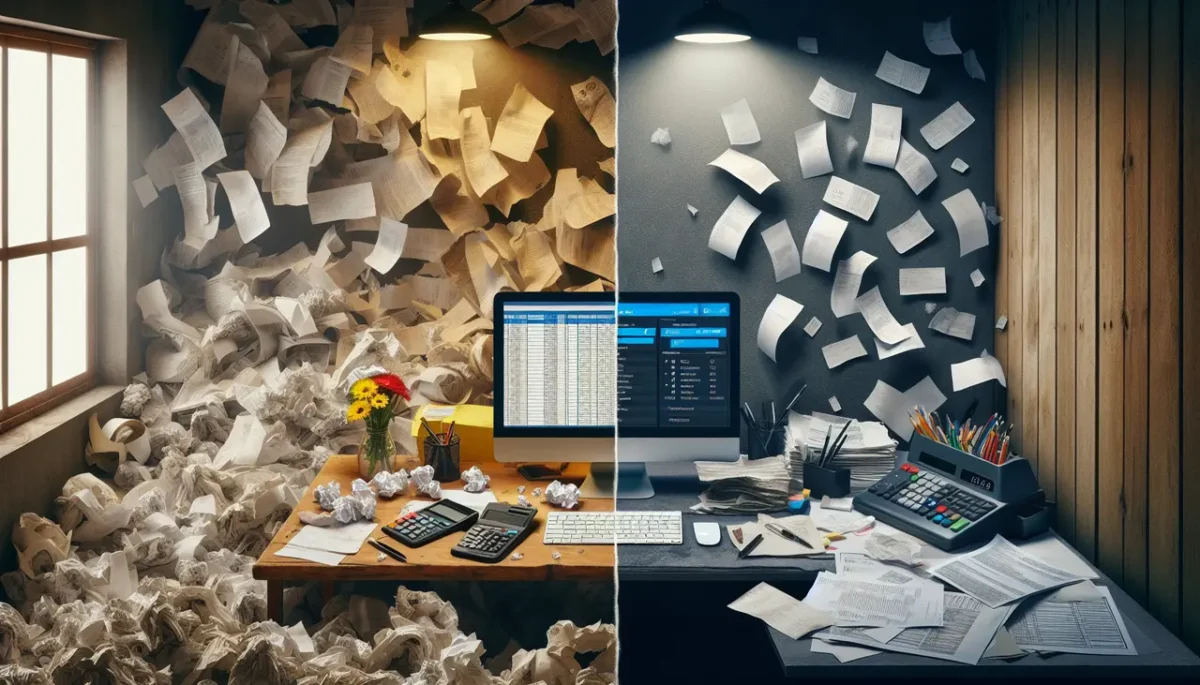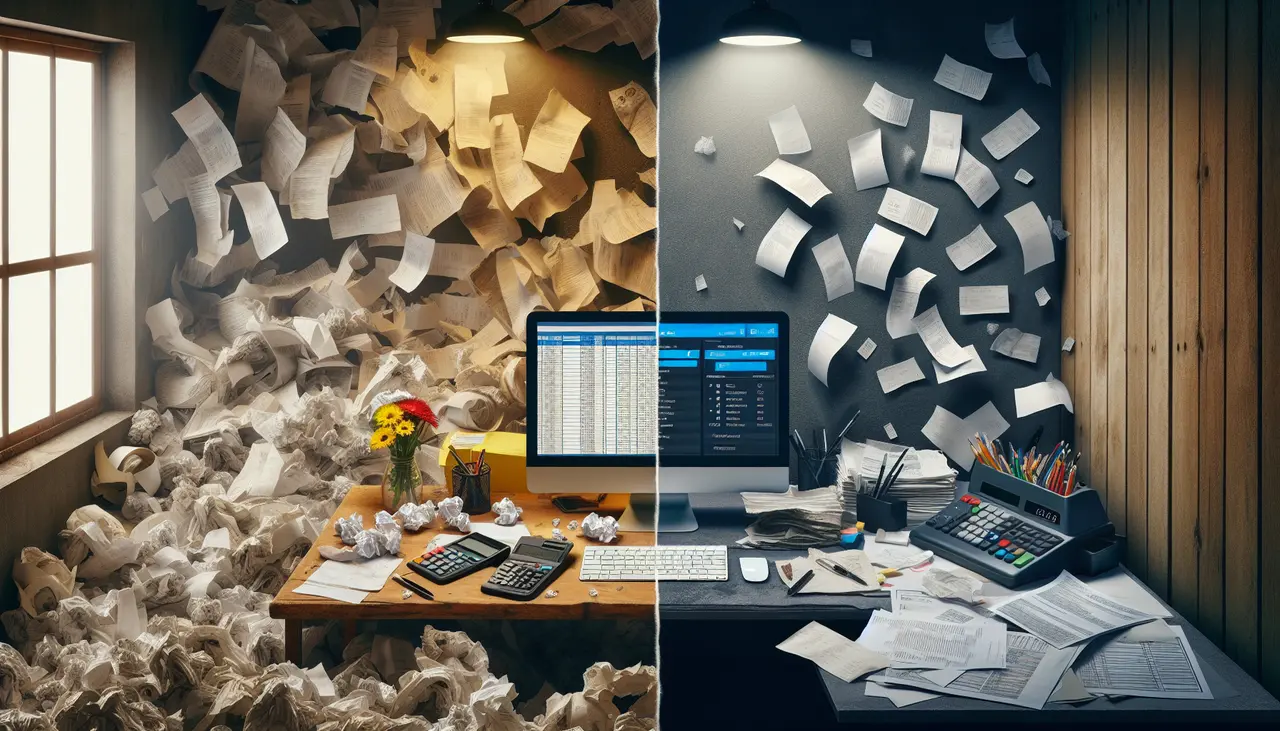Introduction to Electronic Receipts
Switching from paper to electronic receipts means stepping into a world where clutter is reduced, and organization is king. In a nutshell, electronic receipts are digital versions of paper receipts. You receive them through email or mobile apps, immediately after a purchase. They look like traditional receipts but live in your electronic devices. This means no more crumpled papers stuffed in wallets or lost in piles at home. It’s not just about tidiness; it’s a move towards sustainability.
By choosing electronic receipts, you’re cutting down on paper use, helping save trees and reducing waste. Plus, they’re easier to manage. Imagine finding a receipt from months ago in seconds, not hours. With electronic receipts, searching for proof of purchase becomes a breeze. So, diving into the digital receipt world isn’t just good for the planet; it’s a smart move for staying organized.
The Environmental Impact of Paper Receipts
Every year, millions of trees are cut down to produce paper receipts, contributing significantly to deforestation. These tiny slips of paper might seem harmless, but they pack a big environmental punch. Besides trees, producing receipts uses vast amounts of water and energy, and the process emits CO2, adding to the greenhouse gases in our atmosphere. Not to mention, most receipts are coated with chemicals like BPA, making them non-recyclable and harmful if they end up in landfills where they can leach into soil and waterways. By switching to electronic receipts, we save trees, reduce waste, and cut down on energy and resource use. It’s a simple change with a big impact on our planet.
Key Benefits of Switching to Electronic Receipts
Switching to electronic receipts can simplify your life in ways you might not have considered. First up, it’s a win for the environment. Less paper means fewer trees chopped down – straightforward and good for the planet. Also, think about the clutter. With electronic receipts, you wave goodbye to piles of paper cluttering your space. Everything’s stored neatly on your device or in the cloud. Convenience is another big win.
Tracking expenses becomes a breeze since you can access all your receipts with a few clicks. No more rummaging through drawers. Plus, it’s safer. Paper receipts can fade, get lost, or even stolen. Electronic ones? They’re backed up and protected. And here’s a bonus, returns and exchanges? Much smoother. Most stores can look up your purchase electronically, making the process faster and less of a hassle. Bottom line, switching makes your life easier, your space cleaner, and the planet a bit happier.
How Electronic Receipts Work
When you buy something, usually, you get a paper receipt. But now, things are changing. Instead of paper, you might get an email with your receipt or see it pop up in an app. This is an electronic receipt. Here’s how it rolls: You make a purchase, the cashier asks if you’d rather have your receipt emailed or available in an app, and you say yes to one. They punch in your email or scan a code on your phone, and bam, you get your receipt digitally. No more crumpled papers in your wallet. These digital receipts save trees, make returns easier because you don’t lose them, and you can track your spending without digging through a pile of paper. Plus, stores can send you deals or info on stuff you like. So, it’s a win-win for you and the planet.
Setting Up a System for Electronic Receipts
Moving your pile of paper receipts to digital might seem like a big leap, but it’s simpler than you think. First, decide whether you’ll use your phone or computer to store them. Many people choose their phones for convenience. Then, pick an app for scanning and managing these receipts. Options like Evernote, Google Drive, and Dropbox are popular because they’re easy to use and can be accessed from anywhere.
Start by scanning new receipts as you get them. For the old ones, set aside some time each week to work through them until you’re all caught up. Remember to organize your digital receipts into folders. Think of categories that make sense to you, like groceries, utilities, or personal spending. This setup makes finding a specific receipt later on much smoother. Regularly back up your digital storage. You don’t want to lose everything if your phone crashes or your computer dies. That’s it! This simple system keeps your receipts in check and your counters clear.
Overcoming Challenges in Transitioning to Electronic Receipts
Moving from paper to electronic receipts might sound simple, but it comes with its own set of challenges. First up, there’s the tech hurdle. Not everyone is a tech wizard, and for some, setting up digital systems feels like learning a new language. Then, there’s the buy-in. Convincing your team or your boss that this switch is worth the effort isn’t always a walk in the park. People fear change, especially when it means altering the way they’ve done things for years. Plus, there’s the task of choosing the right platform.
With a sea of options out there, picking the one that fits your needs while staying within budget can feel like finding a needle in a haystack. Don’t forget about security concerns, too. The digital world is full of threats, and protecting sensitive information is paramount. Despite these hurdles, the move to digital receipts is a leap towards efficiency, organization, and environmental friendliness. With some patience and strategic planning, those challenges can turn into mere speed bumps on the road to digital ease.
Integrating Electronic Receipts With Accounting Software
To smooth out your shift from heaps of paper to digital records, integrating electronic receipts into your accounting software is a game changer. This move not only tidies up your financial management but also streamlines the process, making it more efficient and less prone to errors. Here’s how it generally goes down: First, choose accounting software that supports electronic receipt integration, if you haven’t already.
Options like QuickBooks, FreshBooks, and Xero are well-loved by many businesses for this very reason. Once you’ve got your software picked out, connecting your electronic receipts involves linking your email where you receive digital receipts or installing a scanning app that syncs directly with your accounting software. This setup means every digital receipt is automatically fed into your accounting system, categorizing expenses without you having to manually input data. What’s beautiful about this setup is it not only saves you time but also ensures accuracy in your financial records.
Say goodbye to misplaced receipts or incorrectly entered figures. And when tax season rolls around, you’re all set with a well-organized digital trail of your transactions. It’s a straightforward shift that brings you closer to a clutter-free, efficient financial management system.
Legal Considerations and Compliance for Electronic Receipts
When you switch from paper to electronic receipts, you need to keep the law in your corner. It’s not just about sending an email instead of printing a slip; there are rules to follow. First off, get clear consent from your customers. They must agree to receive receipts electronically. And it’s not just a one-time nod; record their preference and make sure you’re transparent about how you’ll use their email. Data protection is another big deal.
Countries have strict laws about handling personal information. In the U.S., the Federal Trade Commission (FTC) sets guidelines to ensure you’re not careless with customer data. Then there’s the IRS. If you’re in the business of keeping electronic receipts for tax purposes, they must be as clear and detailed as the paper versions. The IRS isn’t fussy about format, but they are about content. Make sure your electronic receipts include all necessary details like the date of transaction, amounts paid, and a clear description of the service or product. Keep these receipts organized and readily accessible.
If the IRS comes knocking, you need to show them your records without delay. Lastly, consider accessibility. Your electronic receipts should be easy for all customers to access and store. Think about different formats that are universally readable and don’t require special software to open. The move to digital receipts offers convenience and efficiency, but it demands respect for legal boundaries and customer trust. Keep these considerations in mind, and you’ll navigate the transition smoothly, staying on the right side of the law and your customers.
Tips for Encouraging Customers to Embrace Electronic Receipts
Getting your customers to switch from paper receipts to digital ones can seem like a hurdle, but it’s not impossible. First off, be upfront about the benefits. Tell them it’s not just about reducing paper waste—it’s also about convenience. Who enjoys stuffing a wallet or purse full of paper these days? Digital receipts can be accessed anytime, anywhere, making returns and budget tracking a breeze.
Next, make the switch easy. If your system requires customers to jump through hoops, you’ve lost them. A simple email signup at the point of sale is all you need. Consider offering a small incentive for those who opt in—maybe a discount on their next purchase or a chance to win a prize.
Be transparent about privacy. In our digital age, folks are wary about where their email ends up. Assure them that their email is safe with you, used solely for sending receipts and the occasional offer, with an easy opt-out anytime.
Lastly, lead by example. Show them their last paper receipt and tell them it can be the last one they ever need. A visual cue can be a powerful motivator. With these steps, transitioning your customers to electronic receipts can be smoother than you think.
Summary: The Future is Digital – Moving Beyond Paper Receipts
The shift from paper to digital receipts isn’t just a trend; it’s a path toward environmental sustainability and organizational efficiency. Gone are the days when you had to sift through piles of paper to find a single receipt. Now, digital receipts offer a clutter-free way to track your spending, returns, and warranties with the tap of a finger. Not only does this save trees and reduce waste, but it also makes it easier to manage finances and expenses.
Retailers worldwide are recognizing the benefits, from faster transactions to simplified record-keeping. Consumers love the convenience. Plus, digital receipts are harder to lose and easier to access, making financial management a breeze. As technology advances, more businesses will likely adopt this eco-friendly approach, moving us closer to a paperless world. Remember, embracing digital receipts means you’re not just keeping up with the times; you’re also contributing to a greener planet and a more organized life.
Ready to simplify your life? Download the Receipts and Returns app today and take the first step toward a paperless, stress-free shopping experience.
Click App Store & Play Store


